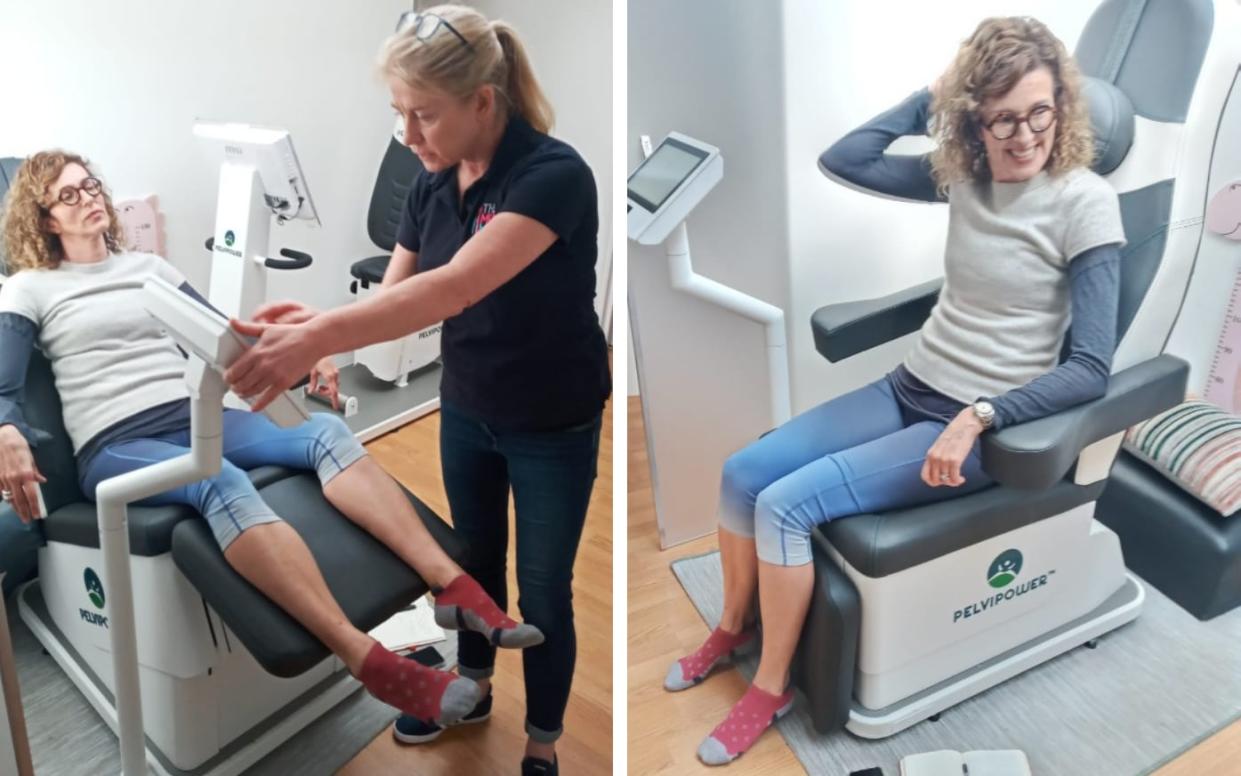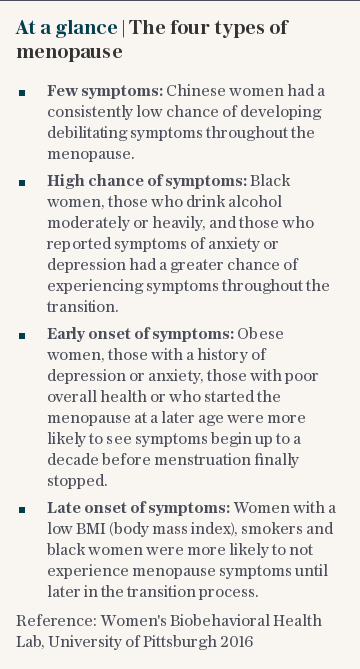‘I tried a menopause MOT and it wasn't what I expected’

It’s a dank Monday morning in a small clinic west of Harley Street the week before London locks down back in March, but it’s not Covid-19 that’s worrying me at present. No, all my attention is focused on the 50 hertz of magnetic stimulation being fired repeatedly into my pelvic floor from the seat of a giant reclining chair, along with the feeling that – how to put this politely? – my uterus is about to fall out of my… Well, you get the picture.
It’s all part of the programme prescribed by physiotherapist Maria Elliott in her new Menopause MOT: 20-minute sessions of pelvic-floor stimulation on the Swiss-made PelviPower machine, which equates to an eye-watering 11,000 Kegels, paired with a tailored exercise routine to target the physical problems associated with declining oestrogen levels.
At 51, I am a lumbering perimenopausal cliché. I can’t sleep. My joints ache. I’ve got a wobbly tyre where my waistline used to be. And I’m just so hot. Add to that the night sweats, low mood, memory loss and fluctuating libido and it doesn’t take a genius to work out what’s going on here. The blood tests from my GP only confirm it. But what to do?
Where “put up and shut up” used to be the only option for the majority of women, now the conversation around menopause is getting louder – and infinitely more confusing. HRT, nutritional supplements, bio-identical hormones and phyto-oestrogens are just some of the options on offer. But Elliott has other ideas, and she’s the first physiotherapist in the UK using PelviPower to implement them.
“The Royal College of Obstetricians and Gynaecologists recommended in 2011 that all women should have a menopause MOT at 50. But there’s still very little out there. We wanted to focus on the physical side here: how you move, if you have pain, what your sleep’s like, what your pelvic floor’s like – women just don’t realise how important that is.”
The MOT starts with a detailed history. “We need to think about physical, mental, emotional, sexual, spiritual, even financial health,” says Elliott. We talk about pregnancies, surgeries, STDs, UTIs, supplements, nutrition, hormone levels, thyroid, skin conditions, allergies, digestion, bone density, mental health – Elliott can refer you on to specialists if you have issues with any of these. “We don’t want to give you a huge to-do list,” she says wryly, “just what’s most relevant for you.”
From a physical point of view, my two biggest problems are sleeplessness and knee pain. I’ve taken up running to tire myself out – but I’ve had two injuries in six months as a result. “Running will help your bones, your heart and your lungs,” says Elliott, “but at this point in your life you might also be diminishing your muscle strength. You need to build up the joints. We can give you exercises to do that.”
A movement assessment with Elliott and her colleague Marta Kinsella Montes reveals more. As I squat, lunge and single-leg dip, I listen to the running commentary between them. “Is there a problem with the right hip?” “Left glute is weak. Longer, stronger right leg.” “Uphill running might be better.”
So it’s not my knees that are the issue? “No, it’s your glutes,” says Kinsella Montes. “Though this is about retraining your brain, too. At the moment, your body is compensating to protect your knees. But if you don’t sort out your gait and the position of your pelvis, you’ll only do them more damage.”
While Kinsella Montes devises a rehab exercise plan, Elliott checks my pelvic floor – from outside and in. It seems I’ve got off pretty lightly so far. “In some women at menopause, issues they may have had after childbirth with their bladder or uterus can recur. So while they’re fine in their forties, in their fifties they can’t play tennis without leaking and, in a yoga class, their organs are prolapsing. Now, do you do pelvic-floor exercises?”

When I admit that though I do, it's not as often as I should, I don’t get the telling-off I expect. Kegels, it seems, are often done wrong, with the release in-between as important as the exercise itself – otherwise, you’re simply training at the end of your range, like doing half a bicep curl. I perform a set of 10 with Elliott’s finger in situ to check I’m getting it right. It’s an odd moment.
Kinsella Montes comes back with my rehab routine: twice-weekly sessions with varying reps of downward dog, child’s pose, four-point swimming, box (a cat with knees off the mat), lunges, wall squats, glute bridge, plank and seated bicep curls. This should help strengthen my glutes and thus sort out my knees, meaning I can run without worry. She also recommends a full blood count and a bone-density scan, just to ensure there’s nothing else going on.
Both she and Elliott agree that I would benefit from sessions on the PelviPower chair. “Pelvic floor rehab is important before you start exercising seriously. You need to power up your pelvic floor so you’re not putting pressure on it and doing more harm than good with strength training.
“Fifty hertz is the optimal frequency for muscle contraction so you get a good strong tension and release with the chair. It can help with stress incontinence and sexual dysfunction, both of which are issues in menopause, too.”
And that’s where we came in: with me on the chair, experiencing the equivalent of 11,000 pelvic squeezes in just 20 minutes, one of the more peculiar moments on this perimenopausal rollercoaster that has become my life.
There’s a vanity factor to all of this, too. Firing up your glutes to save your knees is notoriously difficult with exercise alone: it means endless repetitions of hardcore squats with very significant weights. The chair is an – almost painless – shortcut, and, as Elliott says, “If your glutes get better, you get a great bottom, too. And isn’t that what women want?”
Five months on, and how does it all feel? My knees don’t hurt when I run, and though I haven't been able to get to the reformer Pilates classes recommended by Elliott for my body type, I’ve been doing yoga online and Kegels under my own steam. And the effects of just two sessions on the chair? I know there hasn't been much to laugh about of late, but I don’t wet my pants when I do.
A Menopause MOT with Maria Elliott is £120. PelviPower training is £720 for six sessions; for more information visit www.meps.org.uk or call 0203 109 0201.


